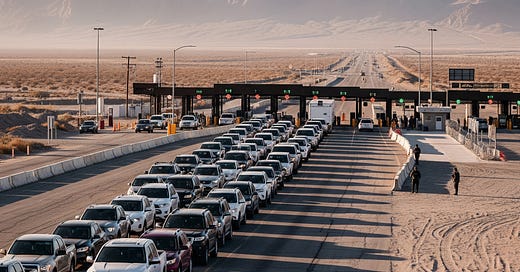AI can Help in Fentanyl Interdiction, but Not How You Think
A Case Study in Rapid Prototyping with DHS
Fentanyl is a direct threat to our homeland.
In 2022 alone, synthetic opioid overdoses stood at a staggering 82,000 people or 76% of all overdoses in the US during that year. Frontier Foundry has covered the fentanyl issue extensively, so if you would like more background or a refresher, please check out these posts:
The numbers do not lie. We know how serious the problem is.
The question is how we start saving American lives in a way that does not assume we can capture enough drug lords or interdict enough shipments to make a difference.
We’ve tried the old way and we’ve seen the results. It’s time to bring the wave of technology that is occurring over the same timeline as the opioid epidemic to bear against this problem. Frontier Foundry did this through a Cooperative Research and Development Agreement (CRADA) with the US Department of Homeland Security in 2024. This is the story of what was built, what we discovered, and how we used AI to find insights that had not been seen before.
Balloons
The CRADA began with a request for information (RFI) that DHS ran in early 2024. DHS was seeking ways to use AI against the fentanyl problem following a statement by then-secretary Alejandro Mayorkas. Our response detailing how Frontier Foundry’s privacy preserving AI could be deployed to move border resources to where they are needed most struck a chord. DHS was immediately interested in the idea and the CRADA was born.
One of the old adages about drug interdiction is the balloon analogy. As the saying goes, when you squeeze a balloon, it pops out somewhere else you weren’t predicting. The analogy is that when you tighten down a particular border crossing or border sector, the drugs would naturally flow elsewhere that border resources were thinner. The problem is about force disposition. Customs and Border Protection (CBP) cannot count on a steadily increasing budget and ever more border agents. It must use AI to be smarter about where it deploys and when. AI can accomplish a lot of feats for CBP agents such as detecting anomalous travel behavior or flagging suspicious vehicles, but those are ultimately one offs. The real value is if the character of the border can change. From the perspective of the cartel that is.
Our proposal was to using existing fentanyl interdiction data to create a new measure of the border that had not been done before. Border volatility (BV). BV is a configuration of our Kundi ensemble AI product that was specifically tuned to look at fentanyl interdictions by state. It calculated the volatility of the border from the perspective of the cartel, meaning where did the cartel see the highest and lowest risks of crossing the border. This measurement turned out to show some amazing insights, even using only interdiction data.
BV is the answer to the balloon problem. BV is a phenomenon that WE control, not the cartels. Instead of squeezing the balloon and being unsure where it would bulge out next, we would enter the decision loop of the cartels, getting us ahead of them. Making them react to us. This was a revolutionary finding.
Views at the Border
What we found out first is that over 90% of all fentanyl interdictions take place in 2 states, California and Arizona. After those states, no other state is significant. Even when interdictions are broken down by weight per border mile, no other state came close to California and Arizona. Texas was a surprising under performer in interdictions even when its long border was accounted for. No northern border state interdicted an amount that even reached 1% of the total interdictions.
From here, we tuned our AI to look at the border and the interdictions as opportunities. Kundi was set up as our adversary, as the cartel. We gave it the interdiction data, which the real cartel would have in some form, and told it to find areas where it would be most advantageous to bring across strategically significant loads of fentanyl. The same amount interdictions of fentanyl (measured in ounces) certainly save lives on an individual level, but do not impact the strategic picture for the US. After getting these results, we used Kundi’s ensemble of AI agents to calculate volatility at the CBP sector level. The result of this calculation allowed us to see where the cartel would find the friendliest, and least friendly, conditions to cross. The cartel might be willing to give up a small interdiction to draw attention away from a large shipment, but the large shipment is too expensive to leave to chance. So, where do they go?
They seek permissive environments. The chances of getting a large shipment across the California or Arizona borders was going to be low, so they need to find the next option that will maximize their chances. The trick is that this is not a static answer, which is why AI is required. If Laredo makes a significant interdiction, the cartel is unlikely to try that crossing again. It will need to shift. But shift to where? This is the balloon problem all over again. BV answers this by showing us the next set of least volatile border crossings broken down by territory controlled by individual cartels. The result?
A list of 5-10 border crossings ranked by volatility score allowing CBP to put the right forces in the right place at the right time.
The cost for this research? $0
The time get first results? 3 weeks
What’s Next
Our CRADA project with DHS demonstrated something important about Frontier Foundry’s AI. With little time and limited data, we were able to turn around something dynamic and that had not been seen before. Because our AI runs lean, this system is deployable on ruggedized laptops in the field where CBP might be without internet. The pieces are all there and the mission is important. Our CBP agents deserve the best we can give them, so they are not responding but making cartels respond to us. AI does that at scale, even with limited data.
Our partnership with DHS is ongoing and we are working on getting access to more data to refine the output. Specifically, we are looking for:
Signals intelligence data
Data on CBP capabilities at each border crossing
Ongoing investigations and arrests
What we need to know is about the interdictions we did not make. It is impossible to estimate how much fentanyl came into the US in a given year. We only know what we interdicted and anything beyond that is an estimate. We can get closer to an accurate estimate by looking at where we detected a probable shipment but did not make the interdiction. The technology is built. The data is there. Access is the only thing that is required.
As the DHS partnership is ongoing, we need to keep our eyes on the fentanyl issue. It is important that people understand that AI offers a solution to this problem, but we need to think about it in the right way. AI can detect travel anomalies, but it can also give strategic advantage. This is strategic advantage.
Seeing Kundi configured and deployed in this way showcases its ability to work against multiple problems. Kundi creates custom analytics that have not been seen before or used by competitors. If you are the only one with a unique insight, that’s called competitive advantage. We demonstrated how CBP can have it and the same system can give it to you.
Connect with us: Substack, LinkedIn, Bluesky, X, Website
To learn more about the AI products we offer, please visit our product page.





